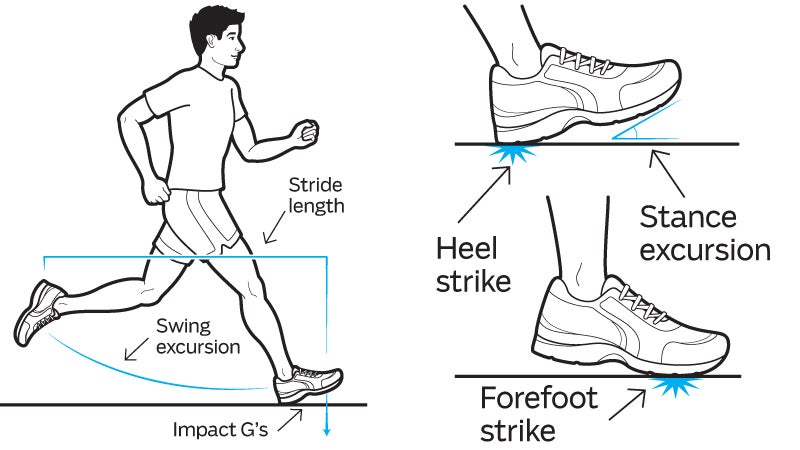A few years ago, when running coach Stephen Magness wanted to assess the biomechanics of one of his athletes, he needed a roll of scotch tape. That’s what he used to affix a very basic accelerometer to the heel of a runner’s shoe, to get a sense of metrics like impact G-force and the directional movement of the foot. It was makeshift, to be sure, but it was the best way he had to get some sense of his athletes’ biomechanics.
These days Magness, who coaches the middle-distance runner Sara Hall and the University of Houston cross-country team, has a more sophisticated method, even if it still involves the runner’s heel. Using a quarter-size wearable sensor called , Magness can establish a stress score for each of his athletes based on 13 parameters and then adjust their training accordingly.
“We want to know how things change with fatigue, so we compare the beginning of a workout to the end, when there is a higher risk of injury occurring,” Magness says. “If an athlete’s pace is staying the same but the time their foot spends in contact with the ground is getting longer, then they’re not producing force on the ground as efficiently as they were in the beginning of the run. If we see these signs of fatigue, then we might change the workload to avoid injury.”
What Magness is doing is part of a larger trend in elite athletics: injury prediction. As sensor technology improves and becomes more practical, so does the ability of coaches and athletes to collect—and react to—more nuanced data. Further, in the past few years, scientists have identified more than 100 genes linked to an increased chance of injuries; the gene COL5A1, specifically, has been connected to Achilles and ACL tears.
“Unlike a sport such as cycling, where crashes are common, most running injuries aren’t sudden—they slowly develop.”
For professional sports teams, as well as major athletic brands that offer athletes high-dollar endorsement deals, predicting who is likely to get injured is worth a lot of money—ideally, they’d invest only in athletes who remain healthy. And as the technology improves, enabling more accurate predictions, some wonder: Will we be able to prevent certain types of injuries?
Of course, football players will continue to hurt themselves knocking into one another, and skiers will still land awkwardly off jumps. But Tim Clark, who helped create RunScribe, thinks running injuries—whether sustained by marathoners or by soccer players sprinting down the field—could soon be a thing of the past.
“Unlike a sport such as cycling, where crashes are common, most running injuries aren’t sudden—they slowly develop,” says Clark. “When you monitor things like pronation and pronation velocity, anomalies are going to show up in the data way before they turn into an injury.”
Major sports leagues and brands are hoping Clark is right. Both the (USOC) and the have recently invested in high-end video cameras, wearables, and other custom data-collection tools, while teams in the NBA, NFL, and NCAA have hired companies like Australia-based Catapult to monitor and predict the health of their athletes.
The technology is also trickling down to the masses. , a smart insole created by Indian startup , and , which use sensors embedded in the fabric to detect force and pressure, are just two recent wearables aimed at injury prevention for amateurs.
Similarly, researchers in Canada have teamed up with 37 clinics around the world to create the , which uses a global database of everyday runners designed to predict injury. Using advanced cameras and 3-D imagery, lead researcher Reed Ferber can look at runners’ biomechanics and tell them whether they run in a way that will lead to injury. Once the data highlights an anomaly—say, a lack of hip strength or a high level of impact G’s—Ferber looks for the root of the problem.
There are potential downsides to all the new data collection. In the future, a young, healthy runner could be refused sponsorship—or a scholarship at a Division I school—if they’re determined to be injury prone.
“We approach an injury like a puzzle with four main pieces: biomechanics, flexibility, muscle strength, and anatomical alignment,” says Ferber. “You can’t do anything about the way you’re built, but you can certainly get stronger and more flexible.”
Genetic testing is still in its infancy, but a 2011 meta-study in the journal determined that “genetic analyses will help to identify individuals with advantageous physiology.” And at least two teams in the English Premier soccer league have contracted with London-based to scour their players’ genes.
There are potential downsides to all the new data collection. In the future, a young, healthy runner could be refused sponsorship—or a scholarship at a Division I school—if they’re determined to be injury prone.
Mounir Zok, a sports technologist with the USOC, doesn’t think there’s much danger of that. Data alone, says Zok, cannot tell coaches everything they need to know about an athlete’s future. Most researchers seem to agree that how one responds to the data is what’s key.
But Ferber believes that, as our understanding of injuries improves, the subtleties it might uncover could be far reaching. “Everyone sits just below the injury zone,” he says. “It’s far more complex than just collecting info about what the foot’s doing. But this is a great start.”
The Little Things That Can Predict Injury

Impact G's and braking G's: The change in vertical and horizontal velocity, respectively, that occurs at the moment a runner's foot hits the ground. Higher G-forces can mean increased injury risk.
Swing excursion: The total angular change in foot position during a stride. It generally increases with speed, and anomalies can indicate fatigue.
Stance excursion: The angular change between foot strike and toe-off. This indicates a runner's strike type.
Strike type: Knee and hip injuries tend to happen more in heel strikers, whereas Achilles, calf, and metatarsal issues tend to befall forefoot strikers.
Stride rate and length: Runners with a higher rate and shorter length of stride tend to exert lower impact G's, which could help prevent injury.
Genetics: Researchers have linked the COL5A1 gene to Achilles and ACL tears. The COL1A1 gene is associated with decreased MCL ruptures and shoulder dislocations.


